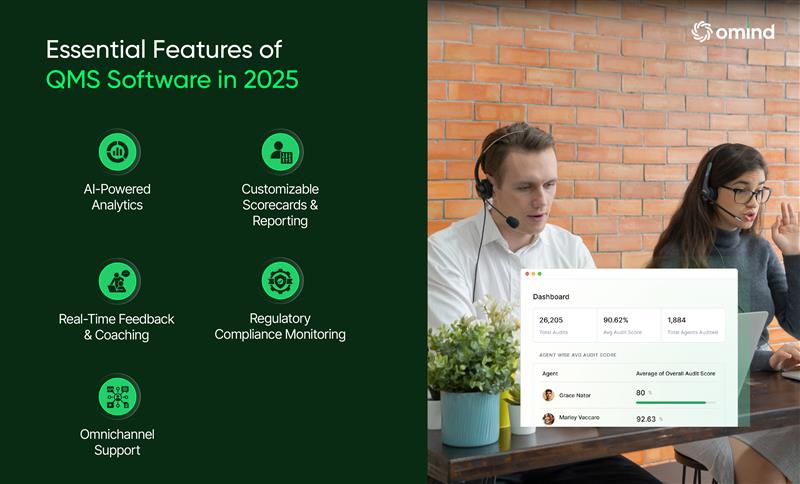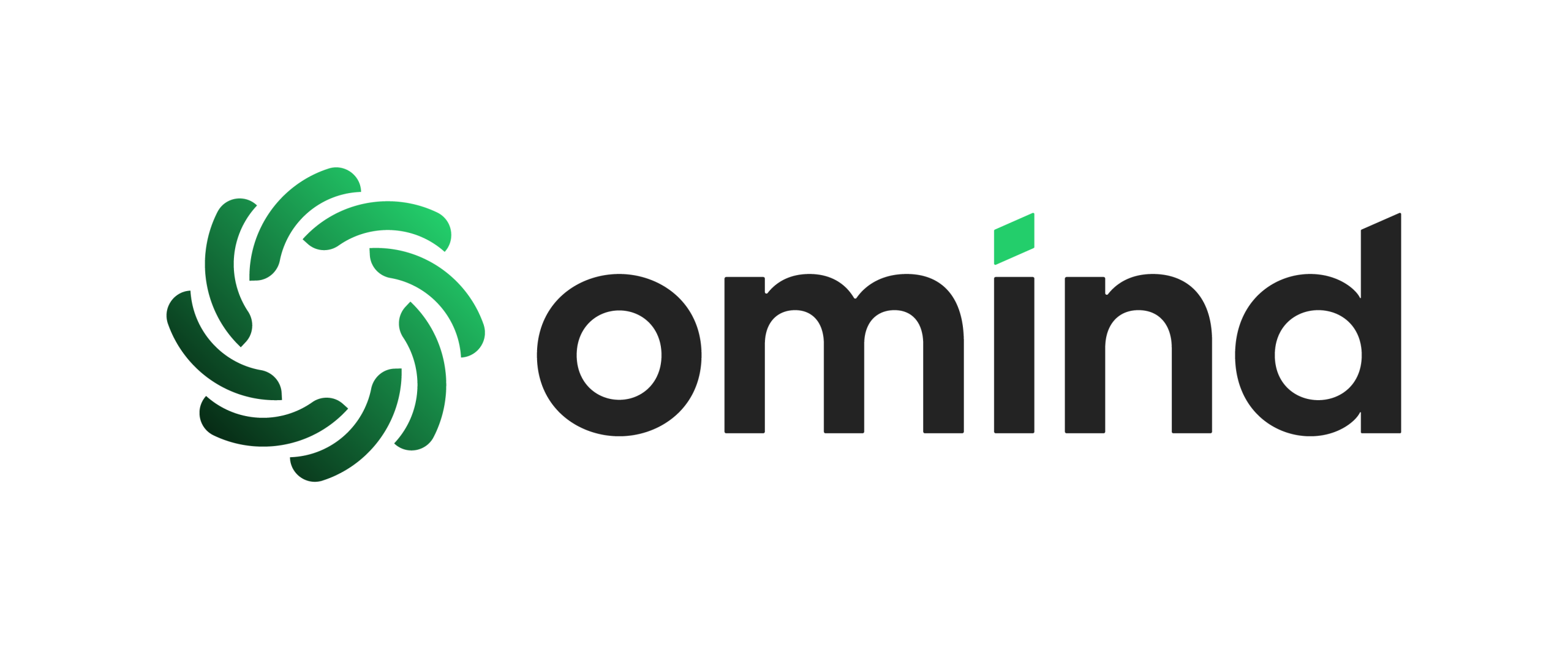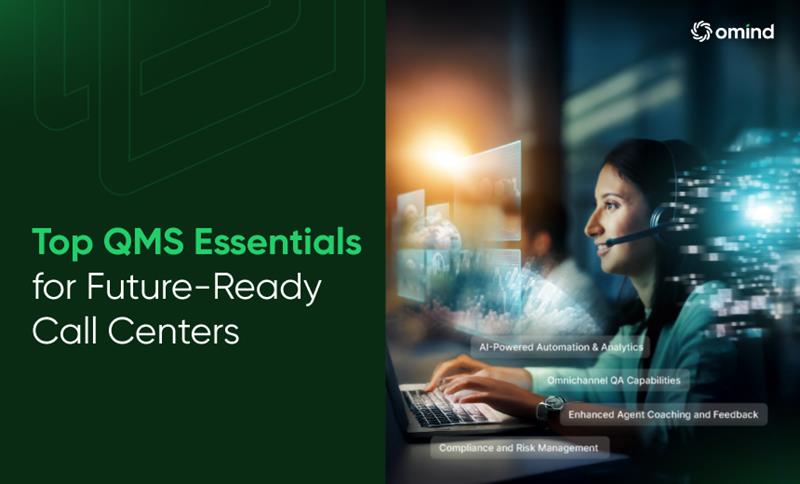In the dynamic landscape of customer service, quality management system software (QMS) has become indispensable for call centers aiming to deliver exceptional experiences while optimizing operations. As contact volumes surge and customer expectations evolve, implementing robust quality management system software can drive significant efficiencies, such as reducing manual QA efforts by up to 30% and enhancing agent productivity. This guide explores the core features, benefits, and implementation strategies for quality management system software tailored to call centers.
Whether you’re combating high turnover or seeking AI-driven insights, discover how solutions like Omind’s AI QMS can transform your contact center into a powerhouse of performance and compliance.
Ready to revolutionize your call center? Explore Omind’s AI QMS for seamless quality management.
Key Takeaways
- • QMS software automates 100% of call center interaction monitoring.
- • Reduces QA costs by 30% with AI-driven analytics.
- • Boosts agent retention by 20-30% through targeted coaching.
- • Enhances CSAT and NPS with real-time sentiment analysis.
- • Ensures 95% compliance accuracy for PCI-DSS, HIPAA, and more.
- • Supports omnichannel QA for unified customer experience insights.
What Is Quality Management System Software?
Quality management system software is a comprehensive platform designed to oversee, evaluate, and improve the quality of processes within an organization. In call centers, this software integrates tools for monitoring interactions, analyzing performance data, and ensuring adherence to standards, all while fostering continuous improvement.
Unlike standalone quality assurance (QA) tools that focus on tactical evaluations—like call scoring—or quality control (QC) systems that reactively address defects, quality management system software provides an overarching framework. It combines QA and QC elements with strategic analytics, risk management, and reporting to align operations with business goals. For instance, while QA might assess an agent’s script compliance on a single call, quality management system software aggregates data across thousands of interactions to identify trends, such as recurring compliance issues or sentiment dips.
The AI Quality Management System Advantage in 2025
In 2025, advanced quality management system software leverages AI and machine learning to automate 100% of interaction reviews, offering real-time insights that manual methods can’t match. This shift not only minimizes bias but also scales effortlessly for high-volume centers. Key differentiators include integration with omnichannel platforms, predictive analytics for forecasting issues, and customizable dashboards that tie QA metrics to revenue outcomes.
Industry research from Gartner predicts that by 2026, more than 70% of contact centers will rely on AI-driven QMS platforms to ensure compliance and deliver personalized coaching.
As Robin Kundra of Omind puts it, “QA is no longer about just measuring the past—it’s about creating real-time insights that drive the future of customer interactions.”
By centralizing these functions, quality management system software empowers call center leaders to maintain consistency, boost customer satisfaction (CSAT), and reduce operational risks in an increasingly regulated environment.
The Benefits of QMS Software for Call Centers
Adopting quality management system software yields transformative advantages, from streamlining workflows to enhancing financial performance. In an industry plagued by turnover rates averaging 30-45% annually—and sometimes reaching 50-60%—this software addresses root causes like inadequate training and burnout through targeted insights.

Boosting Agent Performance and Retention
Quality management system software identifies top performers and skill gaps via automated scoring and feedback loops, enabling personalized coaching that can cut turnover by 20-30%. Features like gamification and real-time assistance motivate agents, fostering engagement and reducing recruitment costs, which can exceed $10,000-$15,000 per hire.
Enhancing Customer Experience and Compliance
By monitoring interactions for empathy, accuracy, and resolution, quality management system software improves CSAT and Net Promoter Scores (NPS), leading to higher loyalty and repeat business. It also ensures regulatory adherence, minimizing fines with automated compliance checks that achieve up to 95% accuracy.
Driving Operational Efficiency and ROI
AI-integrated quality management system software processes data swiftly, uncovering bottlenecks and optimizing staffing. Organizations report impressive ROI—up to 304% with tools like AI-powered contact centers—and payback periods under six months. Overall, it can reduce operational costs by 20-30% while accelerating productivity growth.
These benefits position quality management system software as a strategic investment, especially with 92% of companies adopting AI for contact centers in 2025.
Essential Features of QMS Software in 2025

To maximize value in call centers, quality management system software must include cutting-edge features that support scalability, automation, and actionable intelligence. Here’s a breakdown of must-haves in 2025.
AI-Powered Analytics
Modern QMS tools go beyond traditional call monitoring by leveraging artificial intelligence. This includes speech and sentiment analysis, which automatically transcribes calls and analyzes the emotional tone of both the customer and the agent. This feature helps supervisors understand if a customer is frustrated or if an agent is showing empathy, flagging interactions that need immediate attention. By analyzing 100% of interactions, supervisors get a comprehensive and unbiased view of performance.
As one industry leader put it, “If manual QA is like listening through a keyhole, AI-powered QMS kicks open the door and shows you the whole room.”
Customizable Scorecards and Reporting
A one-size-fits-all approach to quality evaluation simply doesn’t work. The best QMS software offers customizable scorecards that let you define specific metrics aligned with your business goals, such as first-call resolution (FCR), adherence to scripts, or average handling time (AHT). These scorecards should be easy to use and generate automated reports and dashboards. This gives managers and agents a clear, data-backed understanding of performance and areas for improvement, helping to create a culture of transparency and continuous improvement.
Real-Time Feedback and Coaching
Waiting for weekly or monthly performance reviews is no longer an option. A top-tier QMS provides real-time agent assistance. This can include on-screen prompts, scripts, or alerts that guide agents during live calls. Supervisors can also receive real-time notifications for potential issues, allowing them to intervene or provide immediate coaching. This instant feedback loop is vital for preventing problems from escalating and significantly improves agent confidence and competence.
Regulatory Compliance Monitoring
In industries like finance and healthcare, maintaining compliance is non-negotiable. QMS software with automated compliance checks can be a lifesaver. It automatically flags interactions that violate industry regulations (like PCI-DSS or HIPAA) or internal policies. This proactive monitoring helps mitigate legal risks and potential fines, ensuring that all agent interactions are handled ethically and legally.
Omnichannel Support
Today’s customers interact with companies across multiple channels—voice, email, chat, and social media. A truly effective QMS must offer omnichannel support to provide a unified view of the customer journey. This means the software can monitor, evaluate, and report on interactions from every channel, ensuring consistent service quality and identifying friction points regardless of how the customer chooses to communicate.
Implementation Guide: 5 Steps to Deploy QMS in Call Centers
Rolling out quality management system software requires a structured approach to ensure adoption and ROI. Follow these steps, with Omind’s AI QMS as an example of seamless integration.
- Assess Your Needs – Evaluate current QA processes, turnover rates, and compliance gaps. Identify KPIs like CSAT targets to align the software with goals.
- Select the Right Solution – Choose quality management system software with AI features, like Omind’s platform, which offers 100% coverage and NLP analytics. Compare options based on scalability and ease of use.
- Integrate and Train – Connect the software to existing systems (e.g., VoIP, CRM) and provide agent training. Omind’s intuitive interface minimizes learning curves, with built-in tutorials.
- Monitor and Optimize – Launch with pilot testing, then use real-time dashboards to track metrics. Adjust scorecards quarterly based on data.
- Measure ROI and Iterate – Track improvements in turnover (aim for 20% reduction) and efficiency. Use predictive insights to refine strategies continuously.
This methodical implementation ensures quality management system software delivers quick wins and long-term value.
Omind AI QMS: The Future of Quality Management
Rather than surveying a crowded market, let’s focus on what truly matters: the AI-driven Quality Management System from Omind. Omind’s AI QMS is purpose-built for call centers, not retrofitted from manufacturing or enterprise tools. It provides 100% AI monitoring, NLP sentiment analysis, real-time coaching, and omnichannel integration—all in one platform.
What sets Omind apart is the combination of affordability and innovation. While traditional QMS vendors emphasize compliance alone, Omind goes further by tying quality outcomes directly to business results like CSAT, agent retention, and revenue growth. Clients have reported 304% ROI potential, a 30% reduction in QA costs, and measurable gains in agent satisfaction.
As Kishore Saraogi of Fusion CX puts it, “In a world of AI, manual QA isn’t old school. It’s prehistoric.” Omind’s AI QMS embodies this evolution, giving call centers the tools to leave sampling behind and step into an era of continuous, real-time quality assurance.
Trust AI QMS to Deliver
In 2025, quality management system software is the key to thriving amid rising demands and turnover challenges. By automating QA, providing actionable insights, and ensuring compliance, it drives efficiency and growth. Omind’s AI QMS exemplifies this, offering end-to-end features that reduce costs by 30% and boost agent retention.
Don’t wait—schedule a demo with Omind today and unlock superior call center performance.
About the Author
Robin Kundra, Head of Customer Success & Implementation at Omind, has led several AI voicebot implementations across banking, healthcare, and retail. With expertise in Voice AI solutions and a track record of enterprise CX transformations, Robin’s recommendations are anchored in deep insight and proven results.


